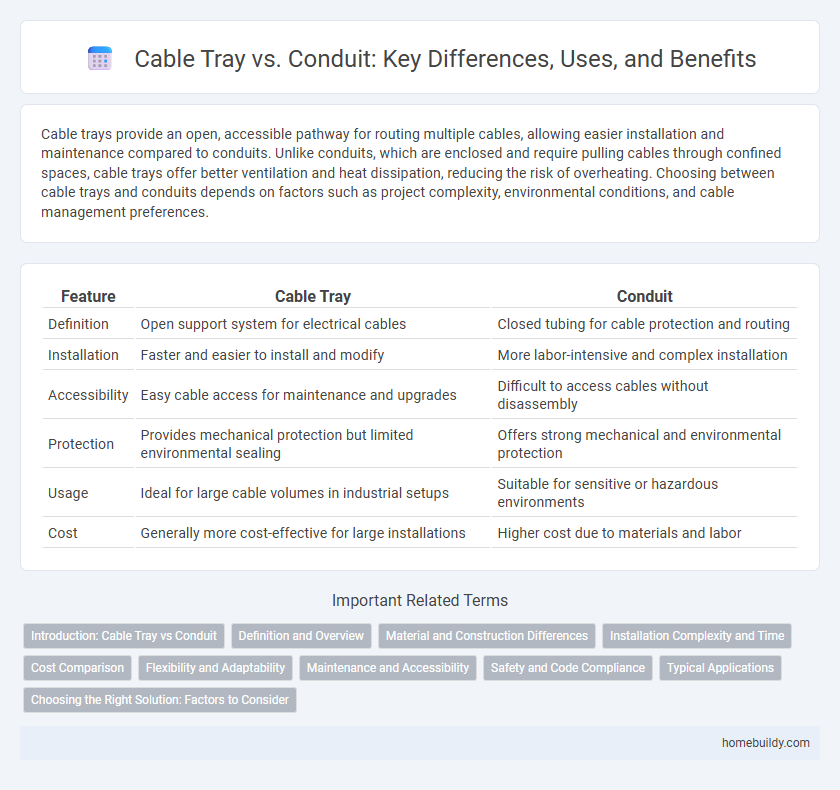Cable trays provide an open, accessible pathway for routing multiple cables, allowing easier installation and maintenance compared to conduits. Unlike conduits, which are enclosed and require pulling cables through confined spaces, cable trays offer better ventilation and heat dissipation, reducing the risk of overheating. Choosing between cable trays and conduits depends on factors such as project complexity, environmental conditions, and cable management preferences.
Table of Comparison
| Feature | Cable Tray | Conduit |
|---|---|---|
| Definition | Open support system for electrical cables | Closed tubing for cable protection and routing |
| Installation | Faster and easier to install and modify | More labor-intensive and complex installation |
| Accessibility | Easy cable access for maintenance and upgrades | Difficult to access cables without disassembly |
| Protection | Provides mechanical protection but limited environmental sealing | Offers strong mechanical and environmental protection |
| Usage | Ideal for large cable volumes in industrial setups | Suitable for sensitive or hazardous environments |
| Cost | Generally more cost-effective for large installations | Higher cost due to materials and labor |
Introduction: Cable Tray vs Conduit
Cable trays provide an open support system for electrical cables, allowing easy access for installation and maintenance, which contrasts with conduits that enclose cables within protective tubes. Cable trays are ideal for managing large volumes of wiring in commercial and industrial settings due to their flexibility and scalability. Conduits offer superior protection against environmental damage and physical impact, making them suitable for harsh or hazardous environments requiring stringent cable safety.
Definition and Overview
Cable trays are structural systems designed to support insulated electrical cables used for power distribution and communication. Conduits are enclosed tubing systems providing physical protection and routing for electrical wiring, typically made from metal or plastic. While cable trays offer easy cable installation and maintenance with an open design, conduits provide superior protection against environmental hazards and mechanical damage.
Material and Construction Differences
Cable trays are typically constructed from materials such as steel, aluminum, or fiberglass, offering superior strength and flexibility for supporting heavy cable loads in large installations. In contrast, conduits are usually made from metal or PVC, designed primarily to protect cables by enclosing them tightly within a rigid or flexible tube. The open design of cable trays allows for better ventilation and easier cable management, whereas conduits provide a sealed environment that guards against moisture and physical damage.
Installation Complexity and Time
Cable tray installation generally requires less time and complexity compared to conduit systems because it involves laying cables on an open structure without the need for pulling cables through enclosed pipes. Conduits demand precise measurements, bending, threading, and often require additional fittings, increasing labor and installation duration significantly. Maintenance and future cable additions are also simpler with cable trays, reducing long-term project complexity.
Cost Comparison
Cable trays generally offer a more cost-effective solution compared to conduits due to lower material and installation expenses. Their open design reduces labor time for cable pulling and maintenance, further decreasing overall project costs. Conduits involve higher costs from additional fittings, labor-intensive installation, and increased material requirements.
Flexibility and Adaptability
Cable trays offer superior flexibility and adaptability compared to conduits, allowing easy modifications and expansions without extensive labor. Their open design facilitates quick access for adding or rerouting cables, making them ideal for dynamic electrical systems. Unlike rigid conduits, cable trays accommodate various cable types and sizes, enhancing overall system scalability and maintenance efficiency.
Maintenance and Accessibility
Cable trays provide superior accessibility compared to conduits, allowing for easier inspection, maintenance, and future cable additions or replacements without dismantling the entire system. Their open design facilitates quick identification of cable issues, reducing downtime and maintenance costs significantly. In contrast, conduits often require more labor-intensive procedures to access cables, making maintenance more time-consuming and costly.
Safety and Code Compliance
Cable trays offer superior safety and code compliance compared to conduits by providing better ventilation and heat dissipation for electrical cables, reducing fire risks. National Electrical Code (NEC) standards specifically recognize cable trays for supporting and protecting cables in industrial and commercial installations. Their open design allows for easier inspection and maintenance, ensuring ongoing adherence to safety regulations and minimizing potential code violations.
Typical Applications
Cable trays are ideal for supporting large volumes of electrical, data, and communication cables in commercial and industrial settings due to their open design that allows for easy cable installation and ventilation. Conduits, typically used in residential or smaller-scale installations, provide superior protection against moisture, dust, and mechanical damage, making them suitable for environments requiring higher durability and safety. Cable trays excel in applications like data centers, manufacturing plants, and large office buildings where frequent cable changes and additions occur, while conduits are preferred in outdoor or hazardous areas demanding secure and enclosed wiring solutions.
Choosing the Right Solution: Factors to Consider
Choosing between cable trays and conduits depends on factors such as installation environment, accessibility, cost, and maintenance requirements. Cable trays offer easier cable management and modifications, ideal for large, complex systems, while conduits provide greater protection against physical damage and environmental hazards in confined or hazardous spaces. Evaluating electrical load, future expansion plans, and compliance with industry standards like NEC (National Electrical Code) ensures the optimal cable routing solution.
Cable tray vs conduit Infographic

 homebuildy.com
homebuildy.com